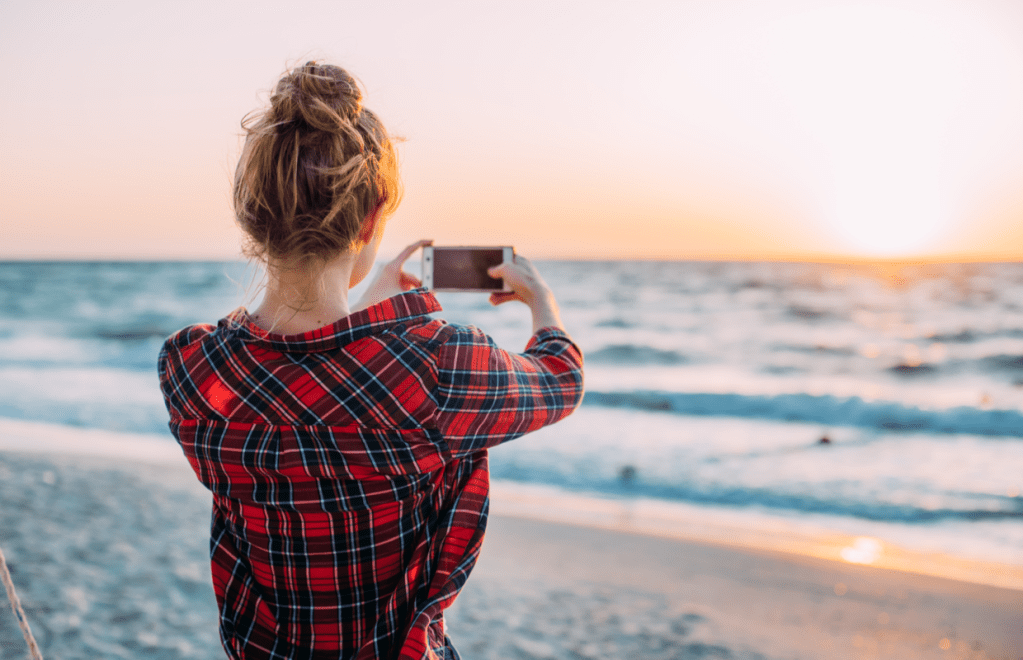Photo journaling for mental health: benefits, ideas and tips
Anita Chaudhuri explores the joy of photo journaling for your mental heath, before sharing her top tips on how to make your own photo journal.

Sometimes, when words don’t come easily, an image can express so much. Discover the joy of photo journaling for mental heath and wellbeing, before learning how to make your own photo journal with these top tips and ideas…
Prior to photo journaling, the joy of journaling is something I discovered at the tender age of 10. I vividly recall receiving my first diary, a five-year volume with a pillar-box red cover. Best of all, it had a padlock and key. No need for the ‘Top secret: Keep out!’ stickers I was so fond of back then.
I’ve kept a journal ever since. There’s a simple joy in documenting for posterity the rocky times, as well as the happy ones. I’ve always incorporated imagery on my pages, sticking in photos cut out from magazines, ticket stubs and brightly coloured doodles, but it was only recently that I discovered the concept of visual or photo journaling through photographer Susannah Conway’s online course, Journal Your Life.
‘The power of journaling with words and images is that it combines creativity and mindfulness with writing,’ explains Conway. ‘People get scared at the thought of writing words on the blank page. It can feel a bit like being at school, where you have to get the grammar right and maybe you think your handwriting isn’t good enough. Taking a photo with your camera phone can feel easier and more accessible than writing.’

From a written journal to photo journaling
I started my photo journal when, during lockdown, something unthinkable happened: I ran out of words. I would sit down, look at the page and… nothing. Every day, with little else to do, I would explore the area in which I had lived for decades, discovering new green spaces. I started taking my camera on these jaunts, or would use my phone to capture a different tree, flower or bird. I slowed my pace, concentrating on finding a subject worthy of my daily photo.
Looking back, I suppose it was away of differentiating one day from the next. It also opened my eyes to so much beauty. Although I’m a keen photographer, I generally opt for gritty city shots. And yet, right here on my doorstep, were secret gardens and wonderful urban trees. Gradually, I began to observe, and consider, my surroundings and community differently.
When you slow down, guess what? People are more likely to stop and chat. Something had shifted and, far from being short of words, I had much to say. I would share my images with rambling captions on Instagram. This habit of photo journaling had an immediate positive effect on my mood.
I later discovered that research from Lancaster University reveals that taking a photo every day and sharing it online increases wellbeing. Participants reported greater self-care, community interaction and enjoyment of opportunities to reminisce. What’s more, a study at Yale University found that when people take photos of experiences, they enjoy them more and are more engaged with the activity.
As the days went by, I wanted to collate my words and pictures, so I started a digital photo journal with the GoodNotes app. A digital journal has the advantage of immediacy. You can share it with friends and there are creative possibilities, such as changing fonts and resizing images. It was like having my own mini magazine!

How to turn simple photos into vivid memories with photo journals
When I began to crave an analogue, tangible experience, I started printing out images to paste in a paper journal. A new daily practice was born. I would choose a favourite photo from my walk and use it as a prompt. Sometimes, I would write about my wanderings and what had happened. Other times, the image would trigger memories.
A coral-coloured rose in the park reminded me of the flowers in my late mother’s beloved garden. Memories flowed onto the page, and so did my tears. But the next day, when I looked at the rose, my heart bloomed! The image was no longer just a photo, it represented a tender moment.
The entry for my lockdown birthday, when my best friend surprised me with a picnic complete with candles on cupcakes, still makes me smile. The words I wrote that day, describing the scene in detail, enhance the photos. As well as being a mindfulness practice and a way of capturing memories and ideas, a photo journal can be a powerful tool for self-coaching.
Conway’s course is split into weekly themes, starting with inner self, then outer self, purpose, dreams and spirit. By setting the intention to address a particular topic or problem, you can use the addition of visuals to access the subconscious mind.
You can do this by taking a photo or series of photos to capture your feelings about an issue, then using the images as a writing prompt. Or if, like me, you take a lot of photos, you can look back and choose a photo from your library that best represents your feelings.

How photo journaling can help with mindfulness and manifestation
‘Look at the photo and ask yourself: what does this make me think of?’ suggests Conway. ‘Or ask: what do I see? Sometimes, just getting the pen moving by simply describing what you see is enough to bypass the inner critic.’
By its very nature, the practice grounds you in the present. Research from Harvard Business School shows that when contemplating objects in the moment, we think visually whereas, when our mind drifts to the future, the brain moves into the realm of language.
There are further benefits from looking back at your pictures. Photo specialists CEWE say people report enhanced positive emotions, such as nostalgia, happiness and inspiration. When you review your words and pictures, you’re not only relishing happy memories.
Photographer Carla Coulson believes that the images you choose to capture contain clues about your hopes and dreams. Her photo diaries documenting her early years as an Australian student in Florence were published as the bestselling book Italian Joy (Penguin, £29.32). ‘Looking back, I could see that I was attracted to certain things that I photographed over and over – people kissing, shrines, flowers, Vespas…’
‘What I realised only years later was that I was capturing everything that was missing from my life. My photos became positive affirmations of what I wanted to attract,’ she says. As it turns out, Coulson’s images predicted her future – a home in Italy with a handsome Neapolitan husband and whizzing around the countryside on the back of a Vespa!

Finding clues, ideas and patterns in your photo journal
At her workshops, Coulson asks participants to prepare by taking one photo a day for a month and compiling the images in a journal. These are shared during the first session. ‘It’s amazing what emerges,’ she says. ‘Most people worry that they don’t have a style. But everyone knows what they like – the problem is that we don’t think that’s enough.’
She suggests that if you want to get the most out of your photo journals, you should look back on them after a month or, better still, six months to a year. ‘The most interesting thing is to look back at the subjects you kept photographing but didn’t know why. What are the recurring colours, textures, ideas or messages in the photo journal? Is there a dominant mood or sensation? Patterns will emerge and there will be clues about what is really going on.
’It’s too early for me to interpret clues from my urban landscapes. I’m not sure how they relate to my future just yet. But, when I look at my lockdown journals, I know that my memories of that time are more vivid and richer in sensory detail than if I had simply used ink and paper to record those strange days.
How to make your own photo journal
Photography is an accessible art that enriches your world. Here are some top tips and ideas to help you make your own photo journal:
1. Choose your journal
If you are planning on writing a lot of text, steer clear of conventional photo albums and opt for a blank book. Daler-Rowney spiral-bound sketchbooks, available in multiple sizes, work well for this.
2. Print your photos
The easiest way is to print images at home and add them to your pages using photo corners. However, if you order prints online, you can always incorporate them later.
In one photo journal, I filled the pages with words and ideas, then added the images with a strip of washi tape (decorative Japanese masking tape) later, so I can lift the pictures to read the text.

3. Organise your tools
If you prefer to make a digital journal, GoodNotes is a useful app for combining words and photos, allowing you to resize and move text and images around the page. You can also add photos to an existing digital diary or other note-taking app, such as Evernote, or create a photo journal document in Word.
4. Make photo journaling a daily practice
By choosing a regular time for photo journaling, it becomes easier to drop into a flow state of writing and reflection.
5. Make a photo box for your journal
It sounds obvious, but storing your prints, photo corners and other materials in one place really does facilitate the photo journaling process.






